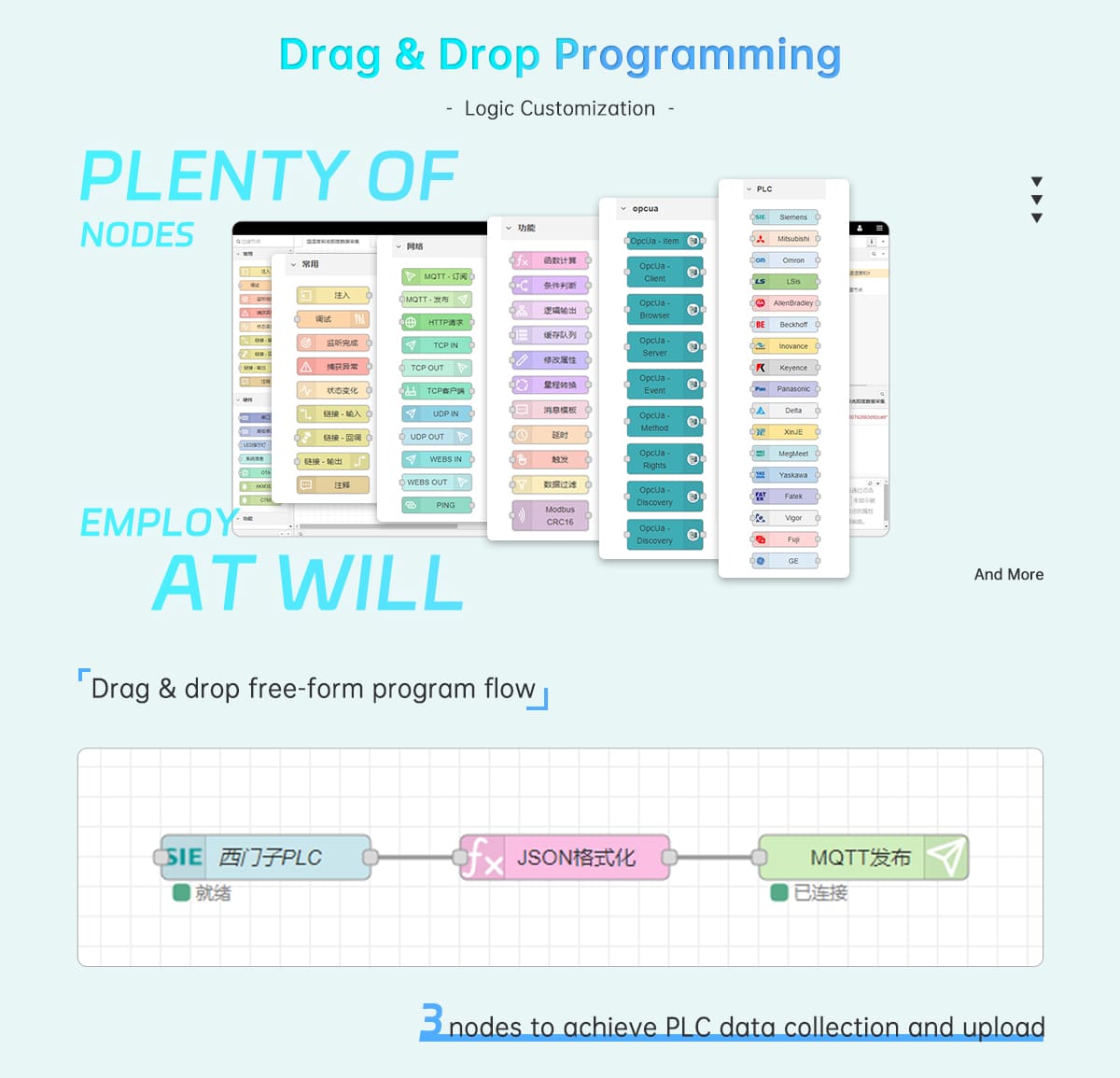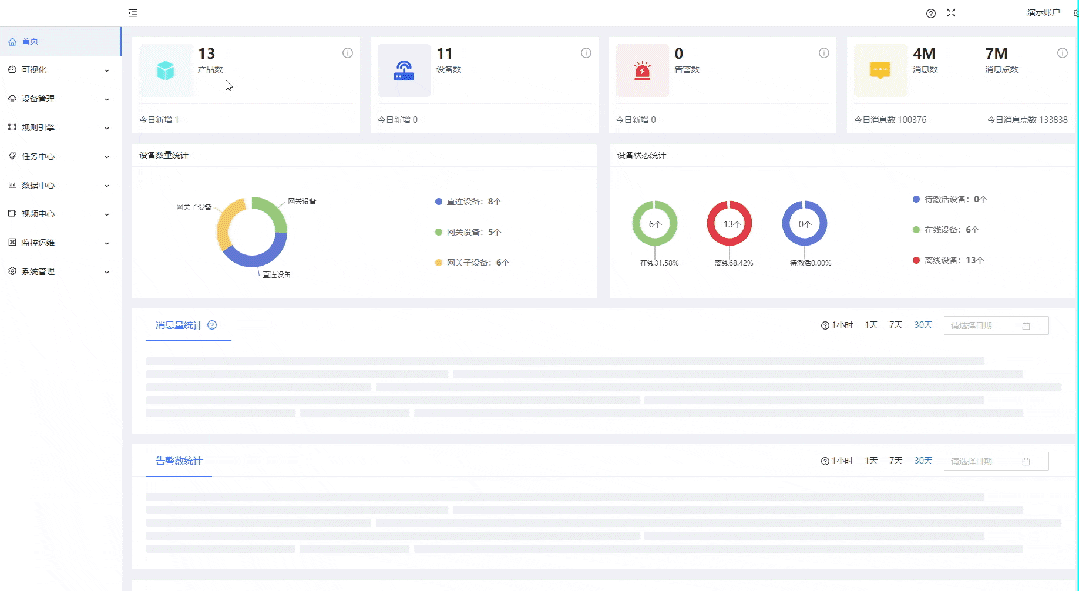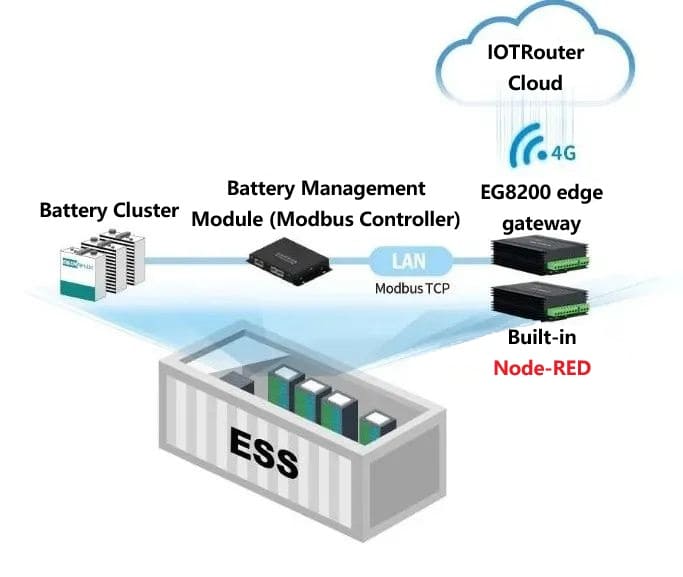“IoT Low-Code Platform! A godsend for IoT developers! With Node-RED, you can quickly build your own IOT apps like playing Legos” – IoTRouter
What is an IOT low-code platform?
What are the existing mainstream IoT platforms?
Why is Node-RED so popular?
IoT Low-Code Platform
1. What is the Internet of Things (IoT)?
The Internet of Things (IoT) refers to the integration of sensors, radio frequency identification (RFID), communication modules, and other equipment, enabling the linkage between objects and data interaction, thereby achieving intelligent control and data awareness in the technology system.
IoT is bringing “data” to “things” in the real world, from machine data collection on the factory floor, to data collection in the oil field to monitor fault alarms, to remote scheduling of city traffic lights.
2. The four-layer architecture of the Internet of Things

Terminal perception layer: deployed in the physical site of the “senses” and “hands and feet”, responsible for collecting environmental data or the implementation of control commands (such as cameras, sensors, smart hardware, etc.);
Network Transport Layer: the access layer, how the device accesses the network (Wi-Fi, 4G/5G cellular, LoRa, NB-IoT, Ethernet, etc.). Transport layer, how data is uploaded and sent down efficiently and securely (e.g. MQTT, CoAP, HTTP/HTTPS).
Platform layer: the “brain” of the IoT system. It is responsible for device management, data collection, storage, analysis, and rule engine execution. This is the core stage for low-code to show its strength.
Application layer: the “window” of value presentation. User-oriented Web interface, mobile App, large-screen signage, or interfaces integrated with other business systems.
3. What is low-code development

Low-code development is a visual interface (such as drag and drop components, flowcharts) to achieve the development of business logic. Its goal is to reduce the development threshold, speed up deployment, so that more business people can also participate in the development.
Node-RED programming interface, especially in the construction of IoT platform, facing the complex device access, protocol analysis, data processing and alarm rules and other needs, the traditional programming development is often a long cycle and high cost. Low-code is the right solution to the practical challenges of “fast, changeable and multiple”.
Mainstream IoT platforms
There are many mature platforms in the IoT field, including:
| Platform | Kenmerken | Low-Code Support |
|---|---|---|
| Alicloud IoT | Enterprise-grade, robust ecosystem, suitable for medium and large enterprises | Partial support through visual configuration |
| ThingsBoard | Open-source, modular, suitable for secondary development | Built-in rule engine, supports low-code |
| Huawei OceanConnect | Secure communication protocols, broad device integration | Certain low-code components available |
| Node-RED | Open-source, lightweight, highly visual programming | Strong low-code capability, highly suitable for IoT scenarios |
| Blynk, Kaa, … | Suitable for specific or vertical scenarios | Partial support |
Among them, Node-RED is known as “Lego blocks for IoT developers”, and has become the low-code engine foundation for a large number of IoT platforms.
A golden partner for IoT development?
Node-RED is a low-code programming framework developed and open-sourced by IBM, which uses a flowchart-style interface to combine various “nodes” to easily realize the complete process from device access, data processing to front-end display.
Four advantages of Node-RED
Visual logic construction: no code is required, just “drag and drop” to realize the process of data acquisition, conversion, storage, and so on.
Lightweight Deployment: Applicable to Raspberry Pi, industrial gateways, edge computing nodes and other devices, with small resource consumption.
Massive node ecosystem: more than 3000 reusable modules, including MQTT, Modbus, HTTP, database, graphical display, and so on.
Highly scalable: supports JavaScript programming to extend node logic, balancing flexibility and ease of use.
IOTRouter Node-RED Low-Code Platform
As an industry-leading industrial IoT solution provider, IOTRouter deeply combines its own accumulation in edge computing, industrial communication and IoT devices to create a Node-RED-based IoT visualization programming platform.

Product highlights
1.Integrated industrial protocol support: built-in Modbus RTU/TCP, OPC-UA, MQTT, IEC101/104 and other common protocol nodes. Support serial port/485/Wi-Fi/4G/Ethernet and other communication methods. Realize plug-and-play for factory equipment without secondary development.
2. Edge computing local execution: Node-RED runs in the industrial edge computing gateway of IOTRouter; the control logic is executed locally without relying on the cloud, which improves response speed and stability.
3. Cloud platform docking: Node-RED can be quickly docked to IOTRouter cloud platform. It supports local data storage, cloud synchronization, and two-way control.
4. Visualization interface + drag-and-drop configuration: through the Web UI management platform, no need to install any software; drag-and-drop logic, click on the configuration, business personnel can also quickly get started.
5. Multi-industry templates out-of-the-box: Provides industry templates for smart agriculture/industry, equipment condition monitoring, energy consumption analysis, etc.; reduces the deployment threshold and accelerates the delivery cycle.

Program Overview
Energy Storage ESS System In this Energy Storage System (ESS) application, the customer needs to realize the real-time acquisition and remote monitoring of key parameters such as operating status, SOC, voltage, temperature, etc. of the battery clusters.
Technology Realization
Gateway deployment: IOTRouter EG8200 Edge Computing Gateway interfaces with the battery management module (Modbus controller) through the LAN interface, and collects battery cluster data using Modbus TCP protocol.
Node-RED process programming: The gateway has a built-in Node-RED low-code programming platform, which realizes data parsing, logical judgment, alarm rule configuration and local data caching.
Cloud Platform Docking: Collected data is uploaded to the IOTRouter cloud platform via 4G network to remotely visualize the battery operation status and realize multi-site unified monitoring.
Solution Value: Fast, Flexible, Reliable
Shorten project cycle: Use low-code tools (e.g. Node-RED) to quickly build application logic on IOTRouter cloud platform, eliminating a lot of underlying coding work.
Reduce development threshold and cost: Non-professional developers can also participate in the implementation of key business logic, reducing the dependence on scarce professional developers.
Enhance system flexibility and maintainability: Visualization logic is clear and easy to understand, and it is more convenient to modify and expand application logic.
Guarantee connection stability: Industrial-grade hardware design ensures continuous and reliable data transmission in complex environments.
Samenvatting
IoT is moving from pilot to scale, and “development cost, deployment efficiency, and maintainability” have become the three keys to push IoT applications to the ground. And low-code technology is precisely in these three points to provide a solution.
Node-RED, as a representative platform of low-code in the field of IoT, is being adopted by more and more enterprises for its openness and scalability. Combining its deep experience in industrial communications, IOTRuter combines Node-RED with hardware platforms to create a complete solution from “end” to “cloud”, which significantly reduces the technical threshold and delivery difficulty of IoT projects.
Want to build IoT applications quickly? Welcome to visit IOTRouter official website to learn more: (Click the button at the bottom right of the screen to contact us!)
Business Cooperation / Technical Consultation: Please leave a message or contact our service team.